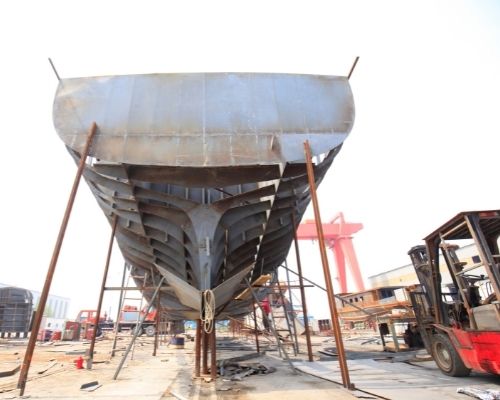Shipbuilding is a dynamic industry that is essential to the strength and growth of the United States, and it plays a key role in our economy on the Gulf Coast. Shipbuilders’ work is hard, not for the faint of heart, and comes with significant work hazards.
Construction may be the most hazardous phase of the shipbuilder’s processes. The amount of equipment needed to complete projects, combined with the amount of personnel required to construct them, means the risk of serious incidents is high.

Almost everything in the shipyard is on a large scale, so it is vital that builders stay attentive and aware of what is happening around them. Here are some of the most common dangers faced by shipbuilders:
Fire, Explosion, and Electrocution
Shipbuilders are exposed to fire, explosion, and electrocution risks on a daily basis. Sparks from welding and machinery can easily ignite flammable materials. While explosions can occur when gases or vapors build up, electrocution is also a common hazard, as contact with energized equipment can be lethal.
Slip and Fall injuries
Slick flooring or loose cables on the floor can cause serious slip and fall injuries. Considering the equipment used by shipbuilders, even the smallest slip can be a disaster. Shipbuilders must be aware of where they are stepping and the conditions in which they are working.
Chemical Hazards
Asbestos is highly resistant to heat and corrosion, making it still common in shipbuilding. Welding, cutting, and brazing are all common work practices. Hazards can include respiratory irritation and systemic poisoning. The risk is greater when builders work in confined spaces. Chemical burns are a common risk to shipbuilders due to their exposure to solvents and other chemicals used during the building process.
Confined Spaces
OSHA defines a “confined space” as one that was not designed for a person to be working there but is large enough for certain jobs. These spaces can include tanks, silos, storage bins, vessels, hoppers, vaults, pits, tunnels, equipment housing, manholes, ductwork, pipelines, and others. Confined spaces are hazardous because they may contain harmful chemicals or gases, have poor ventilation, and/or be difficult to escape from in the event of an emergency.
Working at Heights
Shipbuilders often work at heights, whether it is on scaffolding, ladders, or crane baskets. The fall hazards are obvious, and serious injuries can occur even from short falls.
Other Common Dangers Faced by Shipbuilders
There are many other dangers that shipbuilders face daily, such as struck-by and caught-in/between hazards. Builders need to be aware of their surroundings and take the necessary precautions to stay safe.
Other common risks include:
At every step of the ship’s construction, shipbuilding companies must prioritize the safety of their workers, ensuring that they have the proper training and safety gear necessary to perform their work.
Protecting the Rights of Injured Shipbuilders
Lambert Zainey Smith & Soso have represented injured maritime workers for more than 40 years. Our maritime attorneys understand the ins and outs of the maritime industry and the laws that govern maritime employers and employees.
If you or a loved one have been injured while working in the shipbuilding industry, we can help you pursue the compensation you deserve. Call us today at (800) 521-1750 to schedule a free consultation.







